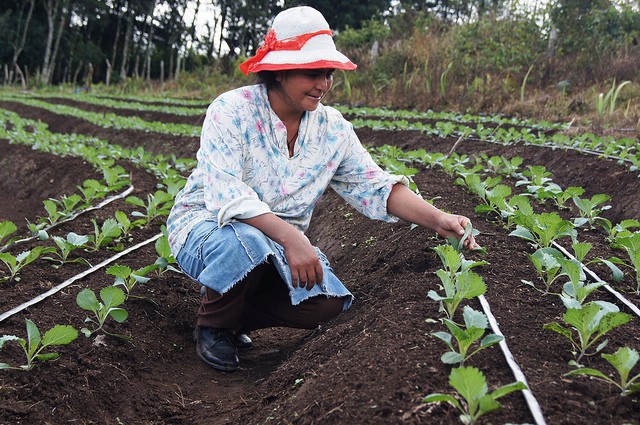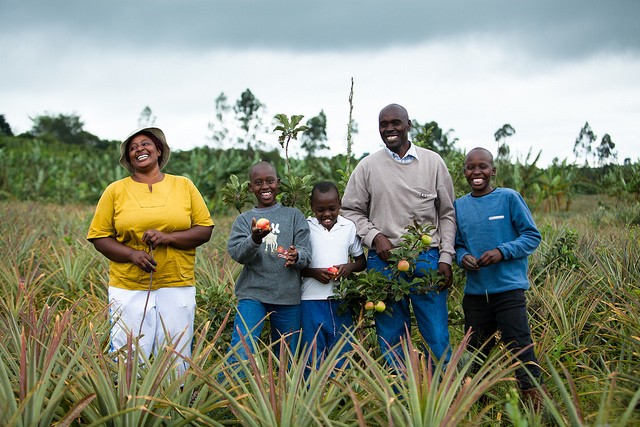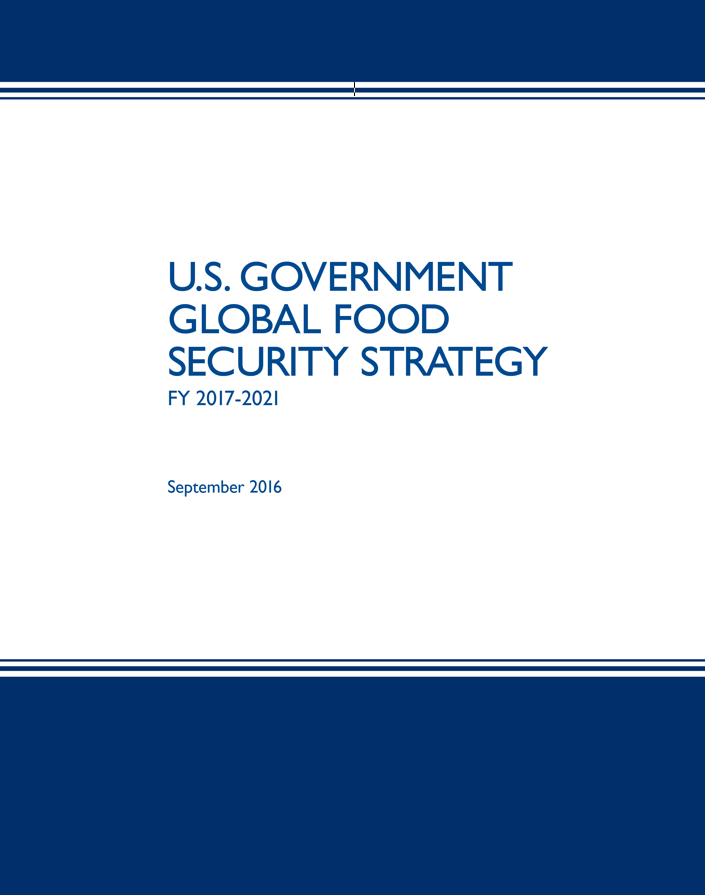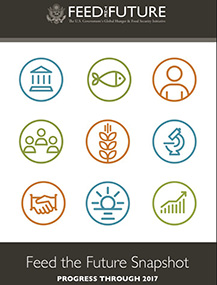- What We Do
- Agriculture and Food Security
- Democracy, Human Rights and Governance
- Economic Growth and Trade
- Education
- Ending Extreme Poverty
- Environment and Global Climate Change
- Gender Equality and Women's Empowerment
- Global Health
- Water and Sanitation
- Working in Crises and Conflict
- U.S. Global Development Lab
For generations, the United States has been a leader in providing development assistance across the globe to alleviate suffering and build shared progress and prosperity. But global food price spikes and resulting instability in 2007 and 2008 were a wake-up call: More needed to be done to break the vicious cycle of hunger and poverty.
The answer: Unlock the potential of agriculture as the key to reducing hunger, extreme poverty, and malnutrition through a movement that became Feed the Future.
Feed the Future, the U.S. Government’s global hunger and food security initiative, has pioneered a comprehensive approach to ending global hunger that draws on partnerships across sectors, country leadership, and a focus on achieving results. With an emphasis on supporting smallholder farmers to strengthen global food security and nutrition, Feed the Future is building on early success to drive real change at a large scale.
The momentum to achieve the long-term vision of Feed the Future – a world where the scourge of hunger, poverty, and malnutrition no longer threaten the peace and prosperity of millions – is strong. U.S. leadership and bipartisan commitment have been integral to driving the progress that Feed the Future has made in just a few years.

Why Food Security?
An Urgent Need
Food, fuel and financial turmoil in 2007 and 2008 pushed millions of people around the world back to the precipice of poverty. Food prices hit all-time highs, sending prices for basic staples like rice and wheat beyond the reach of the world’s most vulnerable people.
The resulting spike in food insecurity worldwide and its destabilizing effects served as a wake-up call to policy makers about the depth of the problem. More needed to be done to address not just the symptoms of food insecurity, but the root causes to break the cycle of poverty, hunger and crisis.
Investing in agriculture was integral. Under the Bush Administration, the United States allocated resources for a near and longer-term response to the food price crisis focused on boosting agricultural productivity, strengthening supply chains, and promoting sound market-based principles for agriculture sector development and regional trade. This approach built on ongoing efforts by African leaders to invest in and revitalize agriculture as a proven means for pulling people out of poverty.
Early success provided a near-term boost to agricultural productivity in West Africa and increased food availability.
What began on a modest scale in several countries through the Initiative to End Hunger in Africa provided the foundation for a more comprehensive, global response to address the underlying causes of food insecurity and malnutrition.
Following the food price crisis, the United States mobilized a movement that is increasing investments in agriculture and approaching implementation of these resources in a new way: One that coordinates efforts across donors and sectors, supports country-owned plans for improving food security and nutrition, and is highly accountable for achieving results.

Feed the Future: A whole-of-government effort
U.S. Agency for International Development
U.S. Department of State
U.S. Department of Agriculture
U.S. Department of Commerce
U.S. Department of the Treasury
U.S. Geological Survey
U.S. African Development Foundation
Office of the U.S. Trade Representative
Millennium Challenge Corporation
Overseas Private Investment Corporation
Peace Corps
Through Feed the Future, the U.S. Government contributes to this global effort, working hand in hand with partner countries to develop their agriculture sectors and improve global food security.
Putting “whole-of-government” into practice, Feed the Future draws on the agricultural, trade, investment, science, development, and policy resources and expertise of departments and agencies across the U.S. Government.
In just a few years, this U.S. Government initiative is already delivering results that are helping reduce poverty and hunger while also improving nutrition for millions of children and families around the world.
“In the past, we thought our job was done when we taught a farmer how to plant a new crop. Today, our job isn’t done until we also help her – and her neighbor – learn how to run a successful business. We don’t want our impact to stop at just one family, business or community. We want communities around the world to see real change at a large scale.”
Sustaining Progress
In May 2015, Sen. Bob Casey (D-PA) and Sen. Johnny Isakson (R-GA) introduced S. 1252, the Global Food Security Act. The bill is similar to legislation that was introduced by Sen. Casey and former Sen. Johanns (R-NE) last Congress.
In March 2015, Rep. Chris Smith (R-NJ) and Rep. Betty McCollum (D-MN), along with 11 other co-sponsors including House Committee on Foreign Affairs Chairman Ed Royce (R-CA) and Ranking Member Eliot Engel (D-NY), introduced a companion bill in the House, H.R. 1567, the Global Food Security Act of 2015. The legislation would authorize and codify international food security programs and is similar to the bill that passed the U.S. House of Representatives last Congress. H.R. 1567 was passed by the House on April 12, 2016.
S. 1252 was approved without objection by the Senate Foreign Relations Committee on March 10 and passed by the U.S. Senate by unanimous consent on April 20.
On July 6, the Senate version of the Global Food Security Act of 2016, S. 1252, was passed in the House of Representatives by a roll call vote, 369-53, under suspension of the rules. President Obama signed this legislation into law on July 20.
The legislation codifies the U.S. Government’s commitment to the productivity, incomes and livelihoods of small-scale producers, particularly women, by working across agricultural value chains and expanding farmers’ access to local and international markets. It strengthens the Feed the Future initiative’s existing accountability mechanisms and establishes parameters for robust Congressional oversight, monitoring and evaluation of impact toward this commitment.
On October 1, USAID submitted an integrated, whole-of-government, five-year strategy on global food security to Congress, as required by the Global Food Security Act.
What Has Feed the Future Achieved?
Led by USAID, Feed the Future leverages the expertise and programs of 10 additional U.S. Government departments and agencies to work in partnership with host-country governments, businesses, smallholder farmers, U.S. universities, research institutions and civil society organizations to promote a comprehensive approach to global food security and nutrition.
We have built a broad network of stakeholders to advance global food security and nutrition through agriculture-led development as a means for sustainable, broad-based economic growth that reduces extreme poverty. Feed the Future is the signature U.S. Government initiative contributing to this global effort.
There is broad bipartisan support for sustaining Feed the Future due in large part to tremendous gains made over the past few years. In countries supported by Feed the Future and other large-scale U.S. Government efforts, local capacity to support food security, agricultural productivity and good nutrition continue to grow stronger.
Looking at changes that occurred in Feed the Future focus areas between 2011 and 2016:
- 9 million more people are living above the poverty line
- 1.8 million more children are living free from the devastating effects of stunting
- 1.7 million more households are not suffering from hunger
- Feed the Future farmers earned nearly $2.6 billion in new agricultural sales
- Nearly $2.7 billion unlocked in agricultural and rural loans to help smallholder farms and businesses grow
Results like these, achieved during the first phase of Feed the Future, have made a significant impact.
Based on average annual rates of reduction measured at mid-term, we project that poverty has dropped by an average of 19% and childhood stunting by 26% across target regions in Feed the Future’s focus countries since the initiative began.
By helping poor families get the tools and the chance to help themselves, Feed the Future is building a more stable world.
For more on Feed the Future’s results and stories of lives changed, view the Feed the Future 2017 Progress Snapshot at www.feedthefuture.gov/progress.











Comment
Make a general inquiry or suggest an improvement.